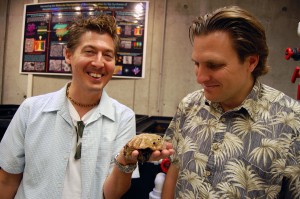Sep 18 2008
A two-year grant is allowing researchers at UCR's Bourns College of Engineering to unlock the secrets behind the enormous strength of the inner pearly layer (nacre) of the abalone shell so it can be replicated in man-made materials. The combined $416,000 grant from General Motors and the University of California Discovery Grant Program has been awarded to Professor David Kisailus, a materials scientist, and his lab in the Department of Chemical and Environmental Engineering.
 Professor David Kisailus (left) a materials scientist at Bourns College of Engineering examines an abalone shell with research associate James Weaver.
Professor David Kisailus (left) a materials scientist at Bourns College of Engineering examines an abalone shell with research associate James Weaver.
“The goal from GM’s point of view would be to create a light-weight, low-cost and tough composite material that could be used for automotive body panels,” Kisailus said. “The resulting material could withstand significant impacts without catastrophically failing. And, it would weigh significantly less than steel.”
Working with GM's Vehicle Development Research Lab in Warren, Mich., the Bourns Engineering team is working to develop super-strong, light-weight body panels and other supports that can be 'grown' inside a porous polymer mold. Among the potential benefits are better protection in crashes, fewer bent fenders in minor collisions and better fuel efficiency.
“Nacre, one of the strongest natural composites known, has many specific features at the micro- and nano-scale that afford its superior mechanical properties,” Kisailus said.
Abalone nacre is made of calcium carbonate and organics organized in a brick wall-like fashion. During nacre synthesis, the abalone first secretes a layered organic matrix of proteins and polysaccharides (the mortar) which is subsequently infilled with a gel-like form of calcium carbonate (the bricks), and ultimately crystallizes to form a nano-composite shell with superb fracture toughness.
The research team, which includes research associate James Weaver, an invertebrate zoologist, will also experiment with manufacturing techniques to mass-produce the pre-formed organic scaffolds.
The nano-composite materials produced at each stage of the research process will be sent to GM's Vehicle Development Research Lab for additional testing and development.
Kisailus said he believes his group was successful in winning the competitive grant because his lab is the only one in his field that is simultaneously approaching the problem from both the materials engineering point of view and from a biological systems approach.